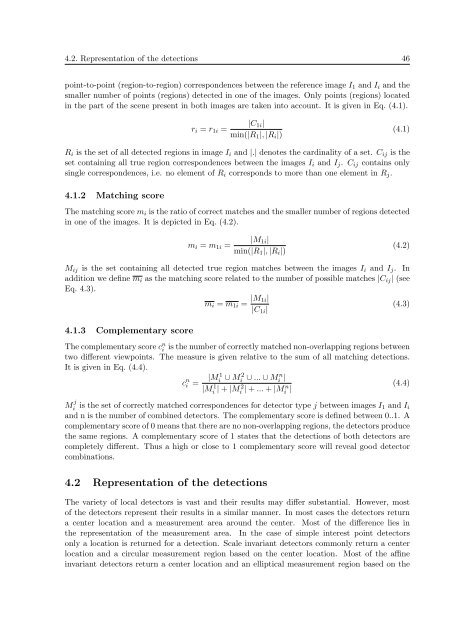PHD Thesis - Institute for Computer Graphics and Vision - Graz ...
PHD Thesis - Institute for Computer Graphics and Vision - Graz ...
PHD Thesis - Institute for Computer Graphics and Vision - Graz ...
Create successful ePaper yourself
Turn your PDF publications into a flip-book with our unique Google optimized e-Paper software.
4.2. Representation of the detections 46<br />
point-to-point (region-to-region) correspondences between the reference image I 1 <strong>and</strong> I i <strong>and</strong> the<br />
smaller number of points (regions) detected in one of the images. Only points (regions) located<br />
in the part of the scene present in both images are taken into account. It is given in Eq. (4.1).<br />
r i = r 1i =<br />
|C 1i |<br />
min(|R 1 |, |R i |)<br />
(4.1)<br />
R i is the set of all detected regions in image I i <strong>and</strong> |.| denotes the cardinality of a set. C ij is the<br />
set containing all true region correspondences between the images I i <strong>and</strong> I j . C ij contains only<br />
single correspondences, i.e. no element of R i corresponds to more than one element in R j .<br />
4.1.2 Matching score<br />
The matching score m i is the ratio of correct matches <strong>and</strong> the smaller number of regions detected<br />
in one of the images. It is depicted in Eq. (4.2).<br />
m i = m 1i =<br />
|M 1i |<br />
min(|R 1 |, |R i |)<br />
(4.2)<br />
M ij is the set containing all detected true region matches between the images I i <strong>and</strong> I j . In<br />
addition we define m i as the matching score related to the number of possible matches |C ij | (see<br />
Eq. 4.3).<br />
m i = m 1i = |M 1i|<br />
(4.3)<br />
|C 1i |<br />
4.1.3 Complementary score<br />
The complementary score c n i is the number of correctly matched non-overlapping regions between<br />
two different viewpoints. The measure is given relative to the sum of all matching detections.<br />
It is given in Eq. (4.4).<br />
c n i = |M i 1 ∪ M i 2 ∪ ... ∪ M i n|<br />
|Mi 1| + |M i 2| + ... + |M i n| (4.4)<br />
M j i<br />
is the set of correctly matched correspondences <strong>for</strong> detector type j between images I 1 <strong>and</strong> I i<br />
<strong>and</strong> n is the number of combined detectors. The complementary score is defined between 0..1. A<br />
complementary score of 0 means that there are no non-overlapping regions, the detectors produce<br />
the same regions. A complementary score of 1 states that the detections of both detectors are<br />
completely different. Thus a high or close to 1 complementary score will reveal good detector<br />
combinations.<br />
4.2 Representation of the detections<br />
The variety of local detectors is vast <strong>and</strong> their results may differ substantial. However, most<br />
of the detectors represent their results in a similar manner. In most cases the detectors return<br />
a center location <strong>and</strong> a measurement area around the center. Most of the difference lies in<br />
the representation of the measurement area. In the case of simple interest point detectors<br />
only a location is returned <strong>for</strong> a detection. Scale invariant detectors commonly return a center<br />
location <strong>and</strong> a circular measurement region based on the center location. Most of the affine<br />
invariant detectors return a center location <strong>and</strong> an elliptical measurement region based on the















